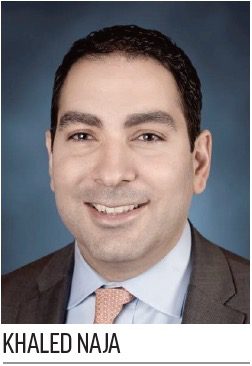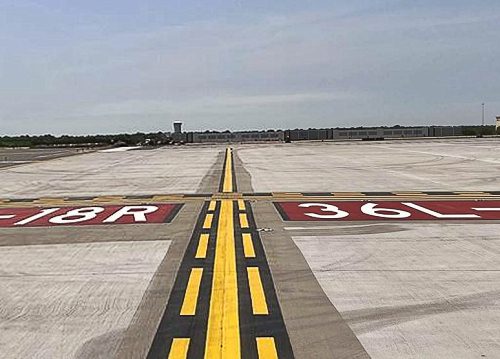It’s not an exaggeration to say that airfield operations at Dallas Fort Worth International Airport (DFW) impact the entire global aviation system. It is, the fourth-busiest airport in the world. When officials determined it was time to rehabilitate one of the critical hub’s seven runways, care was given to the design, planning and phasing of the project.
It’s not an exaggeration to say that airfield operations at Dallas Fort Worth International Airport (DFW) impact the entire global aviation system. It is, after all, the fourth-busiest airport in the world. So when officials determined it was time to rehabilitate one of the critical hub’s seven runways, considerable care was given to the design, planning and phasing of the estimated $130 million project.
At 13,400 feet long, Runway 18R-36L serves as the primary western arrival runway and primary runway for cargo operations. Overall, it handles fully 44% of daily arrivals and provides critical capacity for the airport. In 2018, Runway 18R-36L logged more than 400 operations per day.
|
Project: Runway Rehabilitation Location: Dallas Fort Worth Int’l Airport Runway: 18R-36L Primary Component: Keel replacement with bonded structural asphalt overlay (vs. full rehab) Other Elements: Shoulder & drainage improvements; runway lighting upgrades; replacement & reconstruction of connecting taxiways; drainage repairs on another runway Estimated Cost: $130 million Funding: Airport capital funds Design Initiated: May 2019 Construction: Feb. 2020-Aug. 2021 Runway Reopened: Mid-April 2021 Designer: RS&H
Program/Construction Manager: Contractor: Austin Bridge & Road Runway Grooving: Cardinal/Int’l Grooving & Grinding LLC
Lighting Supplier: Asphalt Placed: 180,000 tons
Pavement Replaced: Drainage Pipe Installed: 6,000 ft.
Under-Drain Pipe Installed: New LED Lights Installed: 3,800
Wire Installed: |
Ready for Rehab
DFW Executive Vice President Khaled Naja explains that the runway was constructed in 1984 and had consequently begun to show its age. In recent years, management noticed an increase in pavement service requests for the aged runway. In fact, since 2010, 26% of all repair orders were related to Runway 18R-36L.
To ensure continued safety and operational efficiency, the airport initiated a self-funded rehabilitation project and engaged RS&H to coordinate the scope and design. Chad Mathes, a senior civil airfield engineer with the firm, says that 18R-36L was exhibiting obvious distresses, like cracking. “We could see from nondestructive testing that some sort of strategic investment was necessary to keep the runway operational,” says Mathes.
Three primary goals guided the rehab project:
- preserving and extending the functional life of the runway,
- enhancing future functional performance, and
- reducing operational impact throughout construction.
In addition to critical pavement improvements, the airport improved infrastructure such as electrical and drainage systems to support safe, efficient operations and enhance the runway’s service life.
Lessons learned from a previous runway project proved pivotal to this project. During the rehabilitation of Runway 17C-35C, the project team determined that the base was in excellent shape, and only the keel needed to be replaced. “We pursued a very similar mitigation for this project (Runway 18R-36L),” explains Naja.
Limiting rehabilitation to keel section concrete repair followed by an asphalt overlay provides DFW with the necessary runway improvements without incurring critical operational impact, Naja explains. And, because the base was still in good condition, a full replacement was not required. The base of 18R-36L is comprised of 17-inch concrete slabs on a cement-treated aggregate base.
The recent project also included shoulder and drainage improvements, runway lighting upgrades and replacement and reconstruction of connecting taxiways. Additionally, crews shored up and repaired a few collapsed soil sites on another runway.

Design began in May 2019, and construction kicked off in February 2020. The runway opened to traffic on April 14, 2021 and is slated for full completion in August 2021. The rehab is estimated to cost $130 million, but Naja expects it to come in just under $125 million.
During the design phase, key stakeholders met at least weekly to strategize about planning and phasing to minimize operational impact. Participants included the project management team, aircraft rescue and firefighter personnel, airfield tenants, operations managers, local police departments, airport management and airline representatives.
 “We brainstormed and looked at alternatives and design ideas together,” says Elliot Neph, an RS&H project manager. “We worked through and evaluated and refined what made the most sense.”
“We brainstormed and looked at alternatives and design ideas together,” says Elliot Neph, an RS&H project manager. “We worked through and evaluated and refined what made the most sense.”
Design Details
On this project, the schedule drove the method. “We had to come up with a technical approach that the client and airport users could accept, based on how long they could be without this critical piece of infrastructure,” Mathes explains.
Per a mandate from DFW, at least two aircraft crossing points had to be maintained at all times throughout construction. So RS&H designed the project to be built in distinctly separate pieces. “It was almost like doing three runway rehab projects instead of just one,” Mathes reflects.
Preparatory work included establishing an onsite batch plant and making sure all aggregate material was on site and ready to go prior to closing the runway.
Next, crews replaced selective sections of concrete and then applied a 6- to 10-inch-thick bonded structural asphalt overlay. This approach allowed DFW to salvage the residual structural capacity of existing pavement and saved a considerable amount of time compared to a full-length, full-depth reconstruction. Because asphalt-over-concrete overlays are prone to reflective cracking, engineers implemented countermeasures like roughening the concrete surface below the asphalt overlay and resealing joints with flexible repair mastic to minimize that potential.
The asphalt overlay used is an FAA P-401 mix with a PG 82-22 binder. Mathes notes that the binder is stiffer than formulas used for highway paving because it is specially designed to support the weight of heavy aircraft without deforming in the Texas heat.

The refurbished runway is designed to handle the heaviest aircraft in the world, including A380s and Boeing 747s. “Our calculations indicate that the Boeing 777, with its triple dual-tandem gear configuration, is the most demanding aircraft on the pavement,” says Mathes.
With 23 connector taxiways, raising the elevation of the runway with an overlay added another design challenge because all taxiways were affected.
To decrease the environmental impact of the project, crushed concrete from this and other DFW airfield projects was used as aggregate base to rebuild the shoulders, and some shoulders were recycled directly into aggregate base by pulverizing them in-place and adding cement slurry. In addition, 20% of the virgin aggregate in the shoulder asphalt mix was replaced with ground recycled asphalt.
All 3,800 of the runway and taxiway lights impacted by the project were replaced with LED fixtures, which will save energy and reduce maintenance costs.

When it came time to groove the new pavement, previous experience helped once again. Working closely with the design team, DFW determined that a saw-cut transverse trapezoidal groove would be optimal for Runway 18R-36L.
 Philip Zuzelo, president of Cardinal/International Grooving and Grinding LLC, notes that square grooves in asphalt subjected to hot temperatures (which DFW receives in spades) will fold over and close. This limits the effectiveness of the grooves and adversely affects aircraft braking capacity, he explains. In concrete pavement, standard 90-degree grooves that are repeatedly pounded by heavy aircraft can chip and pose foreign object debris hazards.
Philip Zuzelo, president of Cardinal/International Grooving and Grinding LLC, notes that square grooves in asphalt subjected to hot temperatures (which DFW receives in spades) will fold over and close. This limits the effectiveness of the grooves and adversely affects aircraft braking capacity, he explains. In concrete pavement, standard 90-degree grooves that are repeatedly pounded by heavy aircraft can chip and pose foreign object debris hazards.
Zuzelo consequently recommends trapezoidal grooves because they more closely resemble a semicircle, which is the most efficient shape to carry water off pavement. Trapezoidal grooves also experience less rubber buildup because of the oblique angles at the top of the grooves, he adds.
Mitigating Challenges
Because of the critical role Runway 18R-36L plays at DFW, it was imperative to prevent construction from hampering flight operations. Converting a vast majority of the project zone to landside space proved to be a key strategy. Although this required about 28,000 linear feet (5.3 miles) of temporary fencing, workers did not have to be badged to be on the site.
“Taking that portion of the project out of the secure area expedited the process so they weren’t hung up getting through security,” says Steve Creamer, vice president of aviation at RS&H.
Due to the timing of the runway rehab, the team also had to contend with implications of COVID-19. “Completing the project during the pandemic was a major challenge for everyone involved,” Mathes relates. “I think we will all remember this as the project we were working on when COVID hit.”

RS&H was in the midst of bringing the contractor on board when everything suddenly had to change. “To be able to shift on a dime and figure out how to make the project happen with unknowns, that was a tremendous feat by everyone,” he reflects.
In addition to the challenges COVID presented throughout construction, the Dallas-Fort Worth metroplex was hit with a massive winter storm in February 2021. Despite the extremely uncharacteristic weather for the region, with historic snowfall totals and freezing temperatures, construction crews carried on.
“The teamwork on this project helped us complete work way ahead of schedule and below budget to upgrade our airfield and help us better serve our customers safely and efficiently for decades to come,” Naja concludes. “The vital partnership we have built with the FAA, our airline partners and our contractors drove the success of the project.”


 facts&figures
facts&figures

